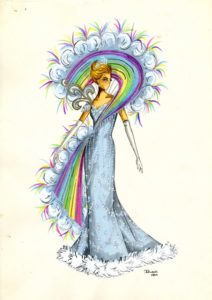Spring 2017
The Goddesses at 100
An exhibit at the Louisiana State Museum focuses on the evolution of women’s krewes in New Orleans from the 1890s to the present
Published: March 1, 2017
Last Updated: October 15, 2018

Arthemise Baldwin, first queen of Les Mysterieuses, 1896.
Named after the Greek goddess of the rainbow, the Krewe of Iris is the oldest current women’s Carnival organization in New Orleans, but it was not the first. That honor belongs to Les Mystérieuses, which held its first ball in 1896 and its second in 1900 before disbanding. Why four years apart? Both years were leap years, which meant that by tradition, women were allowed to assume the lead in courtship. Crescent City women extended that privilege to Carnival, which provided the social scaffolding for courtship. Earlier in the decade, this sort of initiative was confined to small parties held in private homes, but Les Mystérieuses went public in a big way—it held its ball in one of the premier spaces of New Orleans, the French Opera House. The krewe reversed the typical practices of all-male Carnival clubs: masked, secretive women invited men attired in formal dress rather than costumes, and the identity of the queen was not revealed, while the king’s name was publicized.
According to oral tradition, the Krewe of Iris evolved from the Yu Chi Club, a social group. The founder, Aminthe Laudumiey Nungesser, guided Iris for more than three decades. From the beginning, the krewe put a feminine stamp on its revelries. The theme of the first ball, in 1922, celebrated the krewe’s namesake, while the following year’s ball took inspiration from the May Queen. Later balls paid homage to Queen Elizabeth I and Cleopatra. The 1949 ball, which commemorated the nineteenth-century performer Lillian Russell, was the first New Orleans Mardi Gras ball to be televised.

Elsie E. Elchinger, first queen of the Krewe of Iris, 1922.
Besides Iris, another notable women’s krewe pioneer was Venus, the first women’s krewe to parade. In 1941 the krewe named for the Roman goddess of love fielded a dozen floats illustrating the theme “Goddesses.” Aminthe Nungesser, Iris’s founder, helped found this krewe as well and served as its captain. As Venus rolled, she announced that “it was time for the women to have the fun of parading, too. The men have had control too long.” Some men, it seems, did not agree. While most spectators welcomed Venus, a few male hecklers threw rotten tomatoes and eggs at the floats. Nonetheless, krewe members were thrilled about their groundbreaking procession, and Venus, undeterred, paraded until 1992.
Venus and Iris are two standouts in the history of women’s Carnival krewes, but as the new exhibition shows, they had plenty of company. After the first generation of women’s krewes—with Iris coming at the end—there were four more distinct periods of Carnival expansion among women. Despite the financial hardships of the Great Depression, several groups formed in the 1930s and early 1940s, including Hypatians, Aparomest, Orion, Elenians, Noblads, and Venus. A flurry of women’s krewes debuted in the dozen years after World War II, including Niobeans, Hera, and Helios. Then from the late 1960s through the 1970s, a considerable number of parading krewes materialized. Among them were several with staying power—Diana, Rhea, Shangri-La, Cleopatra, and Isis. The most recent cohort of women’s krewes was ushered in by Muses in 2001. While the next women’s krewes didn’t appear until the 2010s, Nyx, Femme Fatale, and Pandora all bear witness to the tremendous popularity of parading krewes, with Nyx even growing to “superkrewe” status in just a few years with its 2000-plus members.
Developed in partnership with the Krewes of Iris, Muses, and Nyx, the exhibition features numerous exceptional artifacts from the museum’s vast collection as well as from various lenders. One of the most prominent is the earliest-known existing Iris queen’s dress, worn in 1941 by Irma Cazenave, wife of Count Arnaud Cazenave, on loan from Arnaud’s restaurant. This newly restored gown is on display with five other costumes, rare photographs, and ball favors, invitations and dance cards from the early twentieth century. Two dozen original costume sketches from several krewes underlines the artistic force behind Carnival. Wayne Phillips, the Louisiana State Museum’s curator of costumes and textiles, points out, “The Krewe of Iris has a legacy of strong, creative costuming, and it’s a great pleasure to highlight the krewe’s costume designers since the 1950s, especially Carter Church, whose relationship with Iris extends back over fifty years.” (Iris even crowned Church its king three times.) Rounding out the exhibition’s must-see list are original tableau ball artworks from Spangenberg Studios, paintings inspired by the Iris, Muses, and Nyx parades, the very first Muses shoe from their inaugural 2001 parade, and a special museum-produced video.
—
Karen Leathem is a museum historian for the Louisiana State Museum.

